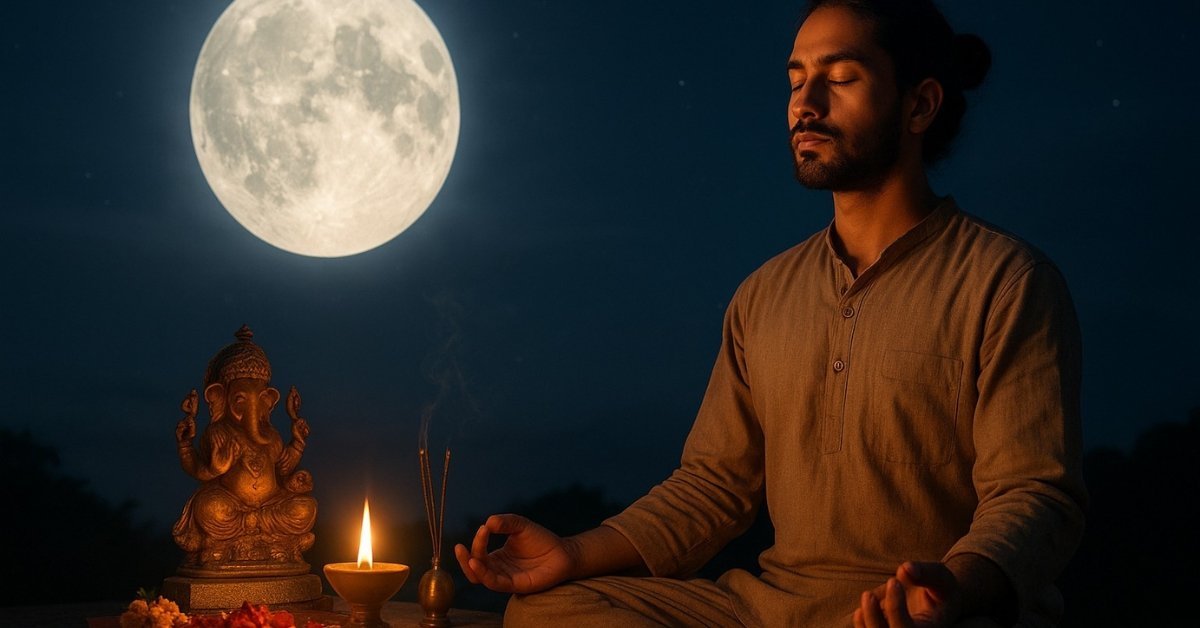Experience the powerful Of Transfom Your Mind & Full Moon Meditation & Puja. Blend ancient Vedic ritual with mindfulness to achieve peace, wellness, and spiritual clarity today.
Transform Your Mind: 4 Benefits Of Full Moon Meditation & Puja for Spiritual Clarity
The full moon has long been celebrated in Vedic tradition as a time when divine energy is at its peak. Its light symbolizes completion, illumination, and release. Performing a Full Moon Meditation & Puja allows you to align your mind, body, and spirit with this celestial rhythm.
When combined with modern mindfulness practices, it becomes a life-changing ritual that cultivates inner peace, gratitude, and spiritual clarity. Whether you’re a seasoned practitioner or a beginner seeking calm, this ritual offers a holistic way to transform your mental and spiritual state.
Why Full Moon Meditation & Puja Matters
In Vedic wisdom, the moon represents Chandra Deva — the lord of emotions and mental clarity. When you perform a Puja during the full moon, you balance emotional waves, release negativity, and attract abundance.
Modern psychology mirrors this wisdom. Studies show that mindfulness meditation reduces anxiety, improves sleep, and enhances focus — benefits amplified under the calming glow of the moon.
Key Benefits
- Promotes mental clarity and emotional stability
- Enhances spiritual connection and self-awareness
- Reduces stress, worry, and restlessness
- Encourages healing, forgiveness, and gratitude
- Helps manifest positive intentions for the lunar cycle ahead
Step-by-Step Guide to Full Moon Puja & Meditation
1. Prepare Your Sacred Space
Choose a quiet corner of your home. Cleanse it with incense or sandalwood. Place a small altar with flowers, lamps, fruits, and your chosen deity’s image. The key is to create a space that feels peaceful and inviting.
2. Set Your Intention
The moon magnifies whatever you focus on. Write your intention — healing, clarity, abundance, or peace — on paper. Keep it on your altar during the ritual.
3. Begin with Mindful Breathing
Sit comfortably, spine upright. Take slow, deep breaths. With every exhale, release tension; with every inhale, draw in the moon’s radiant light. Allow your body and mind to settle.
4. Perform the Vedic Puja
Offer flowers, fruits, or water. Light a lamp and chant:
Om Chandraya Namah or Om Namo Narayanaya
Visualize divine moonlight washing away negativity, blessing your home with purity and serenity.
5. Meditate in Stillness
Close your eyes. Focus on the moon’s image in your mind. Let your thoughts drift by like passing clouds. Stay in meditation for 15–30 minutes, absorbing the vibration of peace.
6. Close with Gratitude
End by thanking the moon, your deity, and the universe. Offer a silent prayer for harmony and prosperity. Journal your feelings or insights — this reflection deepens mindfulness.
Tips to Enhance Your Full Moon Meditation
- Sit where moonlight directly touches your skin
- Play gentle Vedic chants or flute music
- Avoid electronics one hour before the ritual
- Drink warm herbal tea afterward to relax
- Repeat this practice every Purnima (full-moon day)
FAQs
Q1. Can I perform the Full Moon Puja alone?
Absolutely. The lunar energy naturally amplifies solo meditation. What matters most is your intention and focus.
Q2. Which deity is best for Full Moon Puja?
You may worship Lord Shiva, Devi Parvati, or Chandra Deva — all represent calmness and light.
Q3. When is the best time to perform the ritual?
Between 6:00 PM and 10:00 PM when the moon is visible.
Q4. How often should I practice Full Moon Meditation?
Monthly — every Purnima — to maintain emotional and energetic balance.
Start your own Full Moon Meditation & Puja today — and transform your mind into a vessel of light and serenity.





+ There are no comments
Add yours